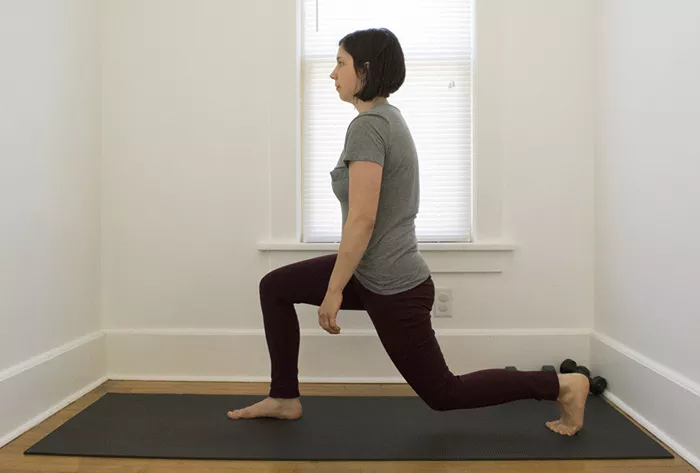The Lunge exercise is a dynamic and effective lower body movement that targets several muscles simultaneously. This exercise is popular for improving strength, stability, and flexibility. It is often included in various workout routines, including cardio workout plans, as it engages muscles in the legs and glutes while enhancing balance and coordination.
Understanding the Lunge Exercise
A lunge is a unilateral exercise, meaning it works one leg at a time. It involves stepping forward with one leg and lowering your body until both knees are bent at a 90-degree angle. This movement engages multiple muscle groups, including the quadriceps, hamstrings, glutes, and calves. It also activates the core for balance and stability.
The primary benefit of lunges is their ability to strengthen the muscles of the lower body. In addition to enhancing muscular strength, lunges also improve joint stability and flexibility. This makes lunges an excellent choice for anyone looking to increase athletic performance, improve posture, or reduce the risk of injury during physical activities.
Types of Lunge Exercises
There are several variations of the lunge exercise, each offering its own benefits and targeting different muscle groups. The most common types include:
- Forward Lunge: The standard lunge where you step forward and lower your body.
- Reverse Lunge: Instead of stepping forward, you step backward into the lunge position, which places less stress on the knees.
- Lateral Lunge: A wide stance is taken as you step to the side, targeting the inner thighs and glutes.
- Walking Lunge: A continuous movement where you alternate lunging forward while walking.
- Curtsy Lunge: A cross-behind variation that targets the glutes and hip abductors.
How to Perform a Basic Forward Lunge
Executing a proper lunge is essential for maximizing its effectiveness and avoiding injury. Here’s a step-by-step guide to performing a forward lunge:
- Step 1: Begin by standing tall with your feet hip-width apart. Engage your core and maintain a neutral spine throughout the movement.
- Step 2: Take a large step forward with your right leg, keeping your back straight and your chest lifted. Make sure your right knee is in line with your ankle.
- Step 3: Lower your body by bending both knees. Your right knee should form a 90-degree angle, and your left knee should be hovering just above the floor.
- Step 4: Push through your right heel to return to the standing position.
- Step 5: Repeat the movement on the other side, stepping forward with your left leg.
Remember to keep your knee aligned with your toes to prevent strain on the knee joint. Maintain proper posture by keeping your chest lifted and shoulders back.
Incorporating Lunges into Your Routine
Lunges are versatile and can be included in various workout programs. They are commonly seen in anaerobic training sessions for their ability to build strength and endurance. Here’s how you can incorporate lunges into your fitness regimen:
- Warm-Up: Begin your workout with a few sets of lunges to activate the muscles in your lower body.
- Strength Training: Add lunges to your strength workouts to target your quads, hamstrings, and glutes.
- HIIT Workouts: Incorporate lunges into high-intensity interval training (HIIT) routines for cardiovascular benefits.
- Leg Day: Lunges are an excellent addition to leg day workouts, complementing exercises like squats and leg presses.
The Benefits of Lunge Exercises
Incorporating lunges into your workout routine can provide numerous benefits, from improving muscle strength to enhancing athletic performance. Some of the key benefits of lunges include:
- Strengthening Lower Body Muscles: Lunges primarily target the quadriceps, hamstrings, and glutes, helping to build strength in these areas.
- Improving Balance and Coordination: Because lunges are performed one leg at a time, they help enhance balance and coordination, which are crucial for athletic movements.
- Boosting Flexibility: The lunge movement stretches and strengthens the hip flexors, hamstrings, and calves, contributing to improved flexibility.
- Enhancing Core Stability: Lunges require core engagement to maintain balance, which helps improve overall core strength and stability.
- Building Endurance: Performing lunges in higher repetitions helps increase endurance in the lower body muscles.
Safety Tips for Lunges
While lunges are an effective exercise, it’s important to perform them with proper technique to avoid injury. Here are some safety tips to keep in mind:
- Use Proper Foot Placement: Ensure that your front knee is directly above your ankle and does not extend past your toes.
- Engage Your Core: Keep your core engaged throughout the movement to maintain balance and protect your lower back.
- Do Not Let the Knee Collapse Inward: Your knee should track in line with your toes to avoid unnecessary strain.
- Start with Bodyweight: If you’re new to lunges, begin with bodyweight exercises before adding weight.
- Use Controlled Movements: Perform the exercise slowly and with control to maximize effectiveness and minimize the risk of injury.
Conclusion
The lunge exercise is a versatile and essential movement for anyone looking to improve lower body strength, balance, and coordination. With its many variations, lunges can be adapted to suit different fitness levels and goals. By performing lunges regularly and with proper technique, you can experience the full benefits of this powerful exercise.
To further enhance your fitness routine, consider integrating lunges with other exercises such as cardio workouts and anaerobic training to create a balanced and comprehensive workout plan. Remember, consistency and proper form are key to achieving optimal results.


